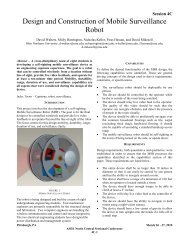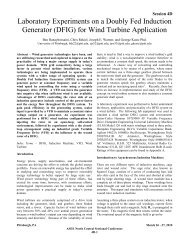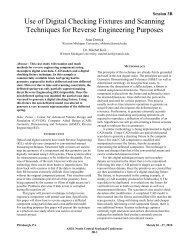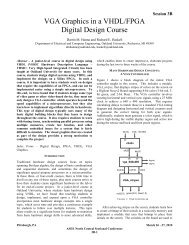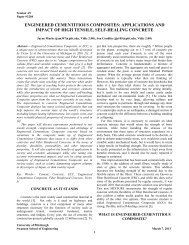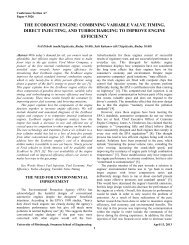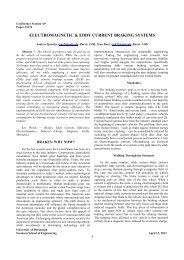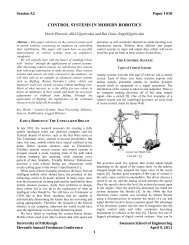Create successful ePaper yourself
Turn your PDF publications into a flip-book with our unique Google optimized e-Paper software.
1118 B9<br />
and emitters are much smaller and would cover a much<br />
smaller area of the screen. Traditional internal reflection<br />
system only required four or five emitters and cameras.<br />
Thinsight technology is still in development; however, it is<br />
believed that these advancements could make infrared touch<br />
screen technology much smaller. The advancements would<br />
also cause the system to be more available for future<br />
consumer touch screen devices.<br />
FIGURE 1<br />
THINSIGHT TOUCH SCREEN INFRARED EMITTERS AND DETECTORS [5]<br />
Microsoft Surface<br />
As mentioned above, the Microsoft Surface is a great<br />
example of internal reflection infrared touch screens. In<br />
early 2001, “Steve Bathiche of Microsoft Hardware and<br />
Andy Wilson of Microsoft Research began brainstorming<br />
concepts for an interactive table”, beginning the<br />
development of the Surface [6]. The process continued in<br />
development until 2003 when the idea was presented to Bill<br />
Gates, and 85 prototypes were created for developers on the<br />
Surface Computing group, a group created in 2004 to solely<br />
develop the Surface. In 2005, various prototypes were<br />
created and analyzed, and eventually, in 2008, the Microsoft<br />
Surface was on sale to the public for $12,500 or $15,000 [6].<br />
The Surface’s “technology uses multiple image sensors<br />
around one side of the touch surface and IR backlights on<br />
the other side. When a user places his finger on the surface,<br />
intercepting the infrared beam, the device projects a shadow.<br />
Using multiple cameras, the unit converts this shadow into a<br />
touch point through triangulation” [3]. As stated by Dr. Hsu,<br />
the Surface uses a system of cameras and IR LED’s to<br />
capture the image of the object touching the surface. The<br />
Surface took a step forward with their technology,<br />
developing a special motherboard to compute the data,<br />
transmitted at 100 megabytes per second, from the cameras.<br />
The board then divides the data into sections that decide<br />
what is relevant and what is not. Relevant data is considered<br />
to be any information from the cameras that has changed<br />
since the last transmission. An example of that is the shadow<br />
from the infrared light changing as someone touches the<br />
screen.<br />
This software is also revolutionary in that it detects and<br />
distinguishes different types of touches. The Surface<br />
categorizes touches into three sets: finger, blob, and tagged<br />
objects. Fingers are given the ability to click on software<br />
application buttons, paint across the screen, and further<br />
interact with the Surface. Blobs are generic objects that are<br />
given a circular or oval reading with a major and minor axis.<br />
Blobs include inanimate objects like paper or other pieces of<br />
technology like smart phones or cameras [7]. Microsoft<br />
products, like the Microsoft Zune music player, can interact<br />
with the Surface just by laying Zune upon the top of the<br />
screen. Multiple Zunes can interact with one another using<br />
the Surface as an intermediary, transferring songs from one<br />
to another. Cameras and phones can also perform similar<br />
tasks with contacts, pictures, maps, and many other pieces of<br />
data. Microsoft has been “initially selling Surface to<br />
Starwood Hotels for guest check in, Harrah’s Entertainment<br />
for video gambling, and T-Mobile for providing customers<br />
with technical information about the company’s mobile<br />
phones” [4]. The Surface allows for the use of tagged items,<br />
specific to where the device is located. Tagged items could<br />
include gambling chips at a Harrah’s Casino or an electric<br />
keycard at a Starwood Hotel. The tagged items give the<br />
Surface very specific data, which includes the facing<br />
direction of the object as well as electric data on the tagged<br />
item itself [7].<br />
FIGURE 2<br />
MICROSOFT SURFACE [6]<br />
Through previous advances in touch screen<br />
technology, Microsoft took a step forward in infrared<br />
systems with their Surface. The Surface’s starting price is<br />
$12,500. This high cost makes the Surface inaccessible to<br />
personal consumers, and is therefore marketed toward<br />
corporations or companies.<br />
RESISTIVE TOUCH SCREENS<br />
Resistive touch screen systems are the most common type of<br />
touch screen technology in today’s market. These devices<br />
are used in many applications, such as cell phones, handheld<br />
games, GPS navigation devices, and even some digital<br />
cameras [3].<br />
The resistive touch screen technology operates in a<br />
very simple way. These screens are built using two layers of<br />
the conductive material Indium Tin Oxide (ITO), separated<br />
University of Pittsburgh April 10, 2010<br />
TENTH ANNUAL FRESHMAN CONFERENCE<br />
2




